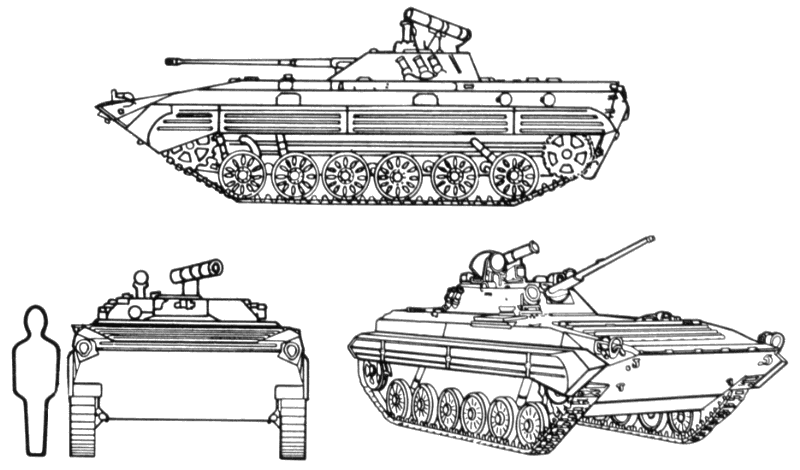The BMP-2 (
Boyevaya Mashina Pyekhoty-2) has an all-welded hull and a three-man crew with the driver seated at the front left, the commander to his rear and the gunner at the turret.
The vehicle is amphibious, being propelled through the water by its tracks.
The elevation and ballistic characteristics of the BMP-2's 30mm, dual-purpose automatic gun enable it to engage helicopters and low-flying, subsonic fixed-wing aircraft at an effective range of 3,000 meters.
The gun's suppressive fire range can be extended to 4,000 meters, depending on the type of ammunition used.
An antitank guided missile launcher atop the turret can employ AT-4 Spigot or AT-5 Spandrel missiles to engage slow-flying or stationary aircraft.
The launcher can be removed from the vehicle and employed while dismounted.
The BMP-2 can use engine exhaust or the six 81mm smoke grenade projectors mounted on the turret to generate screening smoke.
The BMP-2 has thin armor that protects it from .50 caliber armor-piercing rounds only over the 60° frontal arc and 23mm ballistic protection within the turret.
It is extremely vulnerable to antitank guided missile, 30mm, and tank fire.
The engine compartment and ammunition storage area, fuel cells, and troop compartment are located so that penetration anywhere on the vehicle will result in a mobility, firepower, or personnel kill.
The BMP-2 was first seen in April 1981 with Soviet forces in Afghanistan.
It also appeared in the Zapad-81 exercise in the Soviet Union in September 1981.
Initially identified with the STANAG designator BMP M1981, the vehicle has the actual Soviet designator of BMP-2.
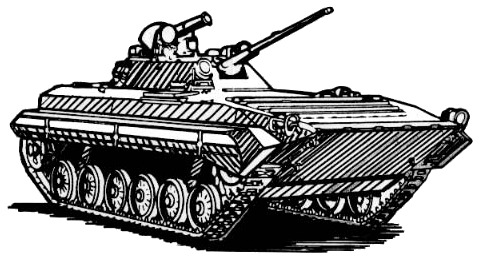
A French SNPE explosive reactive armor (ERA) kit and others are available for use on the BMP-2. However, during dismounted troop
movement, ERA would be a hazard. Thus, passive armor is more likely and ERA application is doubtful. For amphibious use, additional
armor application is unlikely. Other options are spall liners, air conditioning, and a more powerful engine.
Russian AG-17 30mm automatic grenade launcher modification is offered for BMP-2.
Russian KBP offers a drop-in one-man turret, called Kliver, with a stabilized 2A72 30mm gun, a 4 Kornet ATGM launcher, thermal sights,
a coaxial 7.62mm MG and improved fire control system.
French-German Flame-V adaptor kit permits the BMP-2 system to launch Milan, Milan-2, and Milan-3 ATGMs.
Thermal sights are available. The Russian SANOET-1 thermal gunner's sight is available. The Russian Trakt/1PN65 thermal imaging (TI)
ATGM night sight is optional. Acquisition range is 2,500 m (NFI). For the launcher in dismount configuration, the Slovenian TS-F ATGM
night sight is available and has a detection range of 4,500 m and recognition range of 2,000 m. The Russian Mulat/1PN86 lightweight
TI ATGM thermal sight has 3,600 m detection range and 2,000 m identification range.
- BMP-2
- 1980. Original production model. See data above.
ATGM load consists of one ready on the launcher and four stowed. They are readily accessible, but require hand loading from an open
hatch. The AT-5 and AT-5B are more likely than AT-4 and AT-4B.
Recognition features:
- Tracked vehicle.
- Six road wheels.
- Low circular turret with long, thin gun.
- Low silhouette with pointed nose.
- Ribbed area on front of vehicle.
- Two rear hatches on top decking.
- Two doors in rear hull.
- Three smoke dischargers on turret side.
- Vision ports on hull.
- Amphibious.
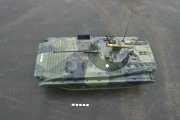
800x533, 92K, JPEG
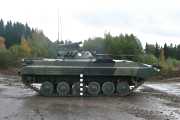
800x533, 107K, JPEG
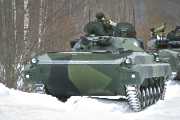
800x533, 118K, JPEG
Finnish Defence Forces Photos
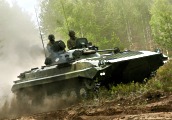
Firing exercise Paiste 07
17-JUN-2007
Finnish Defence Forces Photo
1024x716, 197K, JPEG
- BMP-2D
- Variant with add-on plate armor, but which cannot swim.
- BMP-2E
- Variant with 6mm steel plates added and track skirts.
- BMP-2K
- Command variant with additional radio.
